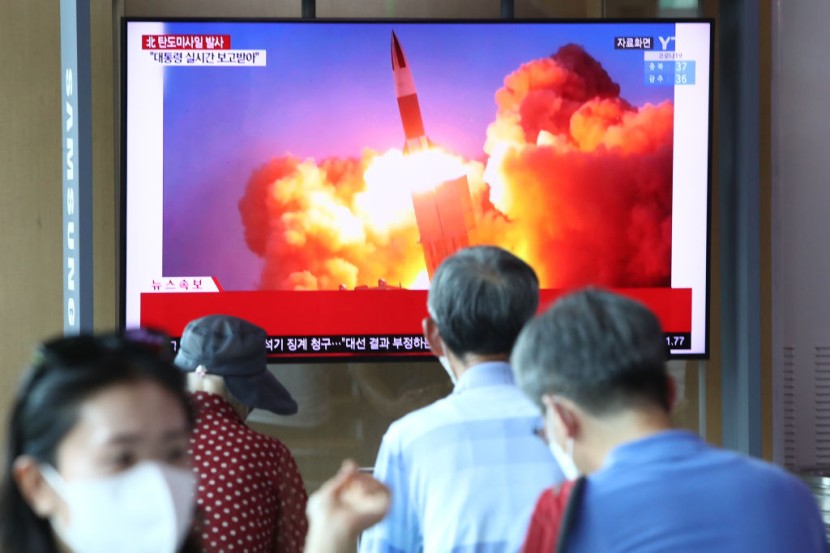
As the East Asian nation indicates intent to assault military bases and operation command systems, North Korea said on Monday that its latest missile tests were designed as practice to "mercilessly" hit South Korean and American targets.
In defiance of recent US-South Korean air force drills, the Democratic People's Republic of Korea (DPRK) heightened geopolitical tensions last week by firing dozens of missiles into the sea. Some locations in South Korea and Japan were evacuated in response to the DPRK's missile testing.
North Korea Missile Tests
Military representatives of the Korean People's Army (KPA) revealed that one of the missiles tested had a unique functional warhead intended with "paralyzing the operating command system of the adversary."
Per Fox News, the military declaration demonstrates Kim Jong Un's determination to stand his ground against US and South Korean soldiers. On Thursday, the two nations released a joint statement warning that any nuclear assaults might terminate Kim Jong Un's authority.
On Monday, the military of North Korea made no mention of any plans to strike the US mainland. Experts believe that nearly every missile fired by North Korea this week was likely a short-range nuclear-capable weapon, bringing US military sites in South Korea within striking distance.
The military of the North claimed to have fired tactical ballistic missiles, super-large, multiple-launch missiles, and a significant test of a ballistic missile with a specific functional warhead tasked with "paralyzing the operating command system of the adversary."
It omitted specifically mentioning a rumored intercontinental ballistic missile launch on Thursday that was intended to strike the US mainland, NBC News reported.
The majority of the short-range North Korean missiles that were fired last week were almost all nuclear-capable. They put important military targets in South Korea, including as American military installations, within striking distance.
Later on Monday, the military of South Korea challenged several of the North's claims regarding its missile testing. The North's cruise missile launches were not detected by South Korea, according to spokesperson Kim Jun-rak, and it is noteworthy that North Korea made no mention of what Seoul believed to be an unusual ICBM flight.
US-South Korea Joint Military Drills
The annual fall air force exercises known as 'Vigilant Storm' between the United States and South Korea this year were the biggest ever. Approximately 240 warplanes, including both nations' powerful F-35 fighter jets, participated in the drills.
The exercises were originally scheduled to last five days, finishing on Friday, but the allies decided to extend the training by one more day in response to the North's missile testing.
The United States flew two B-1B supersonic bombers over South Korea on Saturday, the last day of the air force drills, as a show of force against North Korea. This was the aircraft's first such flyover since December 2017.
The B-1Bs' involvement in the joint exercises, according to South Korea's Joint Chiefs of Staff, showed that the allies were prepared to "sternly respond" to North Korean provocations and that the US was committed to defending its partner with all of its military resources, including nuclear.
Particularly in times of high tension, Pyongyang has denounced the use of US strategic weapons like B-1Bs and aircraft carrier strike groups. The US Air Force refers to the supersonic B-1B "Lancer" aircraft as "the backbone of America's long-range bomber force" although it no longer carries nuclear bombs.
The Lancer can carry up to 34 tonnes (75,000 pounds) of weaponry, including laser-guided bombs and cruise missiles, according to the USAF. By refueling in-flight, the B-1B's range may be increased, enabling it to carry out attacks anywhere in the world, as per Daily Mail.
North Korea would view the deployment of the B-1B as a "serious danger" given its standing as a strategic US asset, according to Ahn Chan-il, an expert on North Korean studies said.
A day before to the deployment of the B-1B, South Korea had scrambled fighter jets in response to the mobilization of what it claimed to be 180 or more North Korean warplanes.
According to experts, Pyongyang is especially sensitive about these drills since its air force is one of its military's weakest points and lacks modern planes and well-trained pilots. Vigilant Storm has witnessed some of the most cutting-edge US and South Korean jets in action, including F-35 stealth fighters, in contrast to North Korea's aging fleet.
Related Article: South Korea Detects 180 North Korean Warplanes Near Border, Prompting Seoul To Scramble Fighter Jets
@YouTube
© 2026 HNGN, All rights reserved. Do not reproduce without permission.







